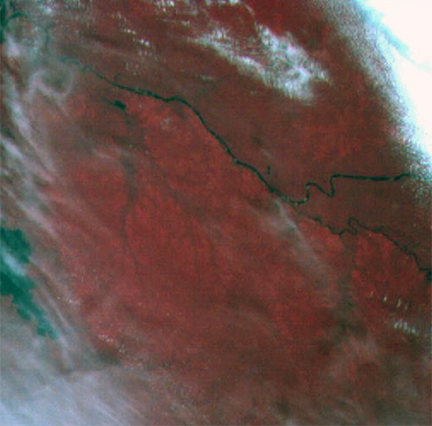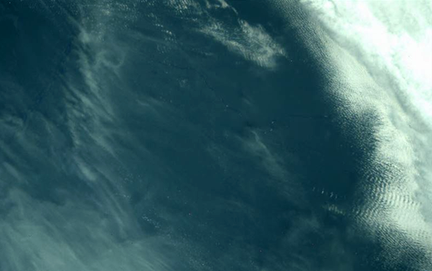
VTT’s hyperspectral imager continues to observe the Earth on board the Aalto-1 smallsat.
For hyperspectral imagers,to reach such a small size and weight is unique, additionally being able to survive in harsh space conditions on-board a small satellite — the imager has even survived a grade X solar storm while still continuing to supply high-quality data.

Spectral image taken over central Africa shows and the Tshuapa river near Mbandaka. The “red edge” of vegetation is clearly visible: the reflectance of the forest rapidly increases around 700 nm. In the image 750 nm is visualized by red pixels, 670 nm by green pixels and 565 nm by blue pixels.
Photo is courtesy of VTT.
The hyperspectral camera on Aalto-1 operates in a wavelength range of 500–900 nanometers and is half a cubesat unit (0.5U) in size, or 5x10x10 cm. While the camera is in space, it has been possible to program the operation wavelengths from Earth, which makes it easy to scale the same camera hardware to enable different applications.

Regular camera image of the same target taken at the same moment as the spectral image. Features of the rainforest are much more difficult to distinguish due to the scattered light from the atmosphere.
Photo is courtesy of VTT.
As smallsats are cost-efficient to launch, it is possible to form constellations of multiple smallsat instruments, which can provide global observation data with better real-time coverage than traditional satellites. This makes it possible to use space technology in the creation of novel service concepts on Earth based on data and AI, expanding to completely new markets such as insurance and agriculture.
Executive Comment
Senior Scientist Antti Näsilä commented on the recent land-target images received from Aalto-1 and stated that it is much more difficult to distinguish these features from the regular camera image of the same target. Hyperspectral imaging can help distinguish information which is not visible from regular images. The severe solar storm in the fall of 2017 was the ultimate test for the ability of the company's hyperspectral camera technology to withstand extreme space conditions.
Research Team Leader Anna Rissanen noted that data obtained from this new spectral range increases the application potential significantly, because the infrared range beyond the visible wavelengths contains much more information about the chemistry and composition of measurement targets. This type of data is useful for example in creating novel service concepts for agriculture or in analyzing composition of asteroids. VTT’s hyperspectral imaging technologies have been developed for a wide variety of wavelengths as well as applications.

